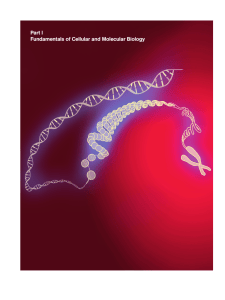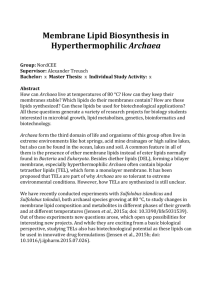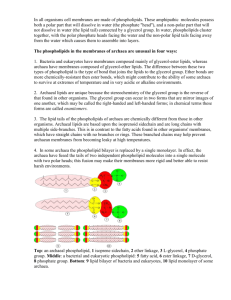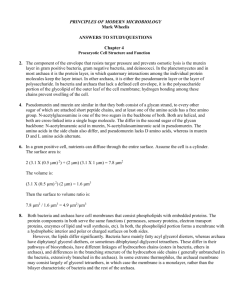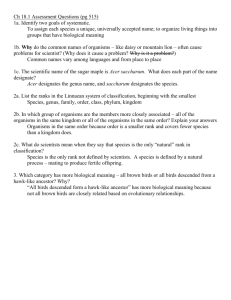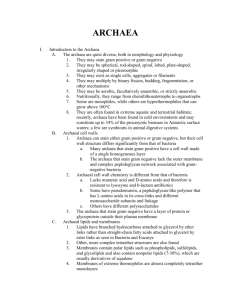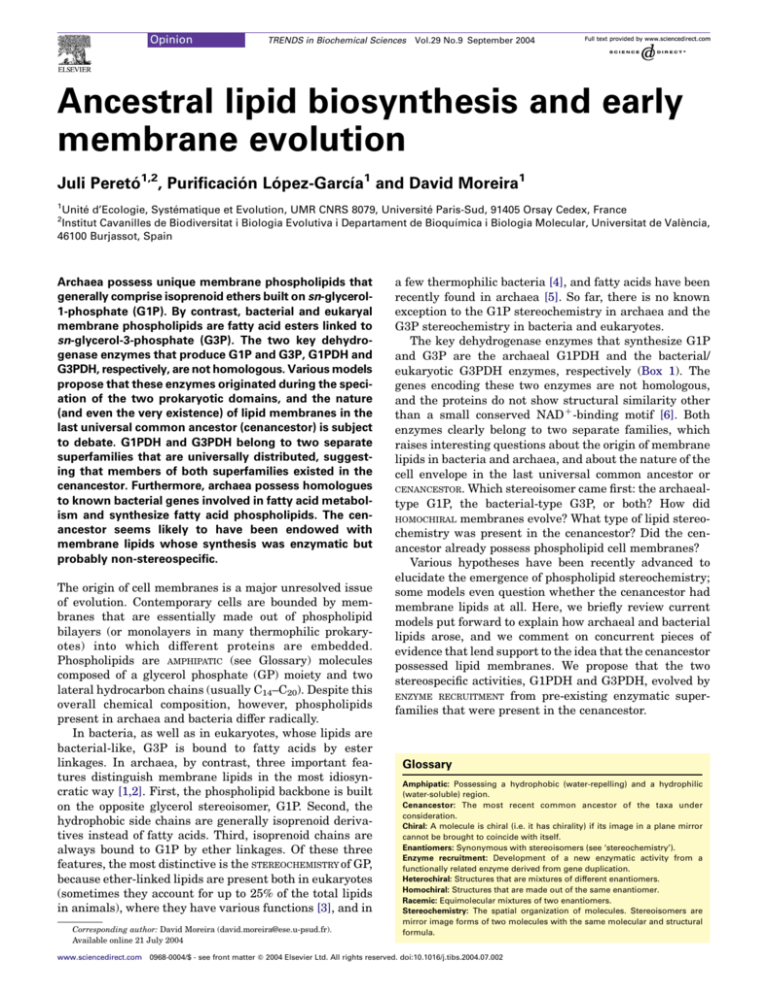
Opinion
TRENDS in Biochemical Sciences
Vol.29 No.9 September 2004
Ancestral lipid biosynthesis and early
membrane evolution
Juli Peretó1,2, Purificación López-Garcı́a1 and David Moreira1
1
Unité d’Ecologie, Systématique et Evolution, UMR CNRS 8079, Université Paris-Sud, 91405 Orsay Cedex, France
Institut Cavanilles de Biodiversitat i Biologia Evolutiva i Departament de Bioquı́mica i Biologia Molecular, Universitat de València,
46100 Burjassot, Spain
2
Archaea possess unique membrane phospholipids that
generally comprise isoprenoid ethers built on sn-glycerol1-phosphate (G1P). By contrast, bacterial and eukaryal
membrane phospholipids are fatty acid esters linked to
sn-glycerol-3-phosphate (G3P). The two key dehydrogenase enzymes that produce G1P and G3P, G1PDH and
G3PDH, respectively, are not homologous. Various models
propose that these enzymes originated during the speciation of the two prokaryotic domains, and the nature
(and even the very existence) of lipid membranes in the
last universal common ancestor (cenancestor) is subject
to debate. G1PDH and G3PDH belong to two separate
superfamilies that are universally distributed, suggesting that members of both superfamilies existed in the
cenancestor. Furthermore, archaea possess homologues
to known bacterial genes involved in fatty acid metabolism and synthesize fatty acid phospholipids. The cenancestor seems likely to have been endowed with
membrane lipids whose synthesis was enzymatic but
probably non-stereospecific.
The origin of cell membranes is a major unresolved issue
of evolution. Contemporary cells are bounded by membranes that are essentially made out of phospholipid
bilayers (or monolayers in many thermophilic prokaryotes) into which different proteins are embedded.
Phospholipids are AMPHIPATIC (see Glossary) molecules
composed of a glycerol phosphate (GP) moiety and two
lateral hydrocarbon chains (usually C14–C20). Despite this
overall chemical composition, however, phospholipids
present in archaea and bacteria differ radically.
In bacteria, as well as in eukaryotes, whose lipids are
bacterial-like, G3P is bound to fatty acids by ester
linkages. In archaea, by contrast, three important features distinguish membrane lipids in the most idiosyncratic way [1,2]. First, the phospholipid backbone is built
on the opposite glycerol stereoisomer, G1P. Second, the
hydrophobic side chains are generally isoprenoid derivatives instead of fatty acids. Third, isoprenoid chains are
always bound to G1P by ether linkages. Of these three
features, the most distinctive is the STEREOCHEMISTRY of GP,
because ether-linked lipids are present both in eukaryotes
(sometimes they account for up to 25% of the total lipids
in animals), where they have various functions [3], and in
Corresponding author: David Moreira (david.moreira@ese.u-psud.fr).
Available online 21 July 2004
a few thermophilic bacteria [4], and fatty acids have been
recently found in archaea [5]. So far, there is no known
exception to the G1P stereochemistry in archaea and the
G3P stereochemistry in bacteria and eukaryotes.
The key dehydrogenase enzymes that synthesize G1P
and G3P are the archaeal G1PDH and the bacterial/
eukaryotic G3PDH enzymes, respectively (Box 1). The
genes encoding these two enzymes are not homologous,
and the proteins do not show structural similarity other
than a small conserved NADC-binding motif [6]. Both
enzymes clearly belong to two separate families, which
raises interesting questions about the origin of membrane
lipids in bacteria and archaea, and about the nature of the
cell envelope in the last universal common ancestor or
CENANCESTOR. Which stereoisomer came first: the archaealtype G1P, the bacterial-type G3P, or both? How did
HOMOCHIRAL membranes evolve? What type of lipid stereochemistry was present in the cenancestor? Did the cenancestor already possess phospholipid cell membranes?
Various hypotheses have been recently advanced to
elucidate the emergence of phospholipid stereochemistry;
some models even question whether the cenancestor had
membrane lipids at all. Here, we briefly review current
models put forward to explain how archaeal and bacterial
lipids arose, and we comment on concurrent pieces of
evidence that lend support to the idea that the cenancestor
possessed lipid membranes. We propose that the two
stereospecific activities, G1PDH and G3PDH, evolved by
ENZYME RECRUITMENT from pre-existing enzymatic superfamilies that were present in the cenancestor.
Glossary
Amphipatic: Possessing a hydrophobic (water-repelling) and a hydrophilic
(water-soluble) region.
Cenancestor: The most recent common ancestor of the taxa under
consideration.
Chiral: A molecule is chiral (i.e. it has chirality) if its image in a plane mirror
cannot be brought to coincide with itself.
Enantiomers: Synonymous with stereoisomers (see ‘stereochemistry’).
Enzyme recruitment: Development of a new enzymatic activity from a
functionally related enzyme derived from gene duplication.
Heterochiral: Structures that are mixtures of different enantiomers.
Homochiral: Structures that are made out of the same enantiomer.
Racemic: Equimolecular mixtures of two enantiomers.
Stereochemistry: The spatial organization of molecules. Stereoisomers are
mirror image forms of two molecules with the same molecular and structural
formula.
www.sciencedirect.com 0968-0004/$ - see front matter Q 2004 Elsevier Ltd. All rights reserved. doi:10.1016/j.tibs.2004.07.002
470
Opinion
TRENDS in Biochemical Sciences
Vol.29 No.9 September 2004
Box 1. Stereospecific biosynthesis of glycerol phosphate
In bacteria, the NADPH-dependent reduction of DHAP catalysed by
the product of the gene gpsA is responsible of the stereospecific
synthesis of G3P, the backbone of bacterial phospholipids. Bacteria
can also generate DHAP from glycerol by using glycerol dehydrogenase (gldA) and dihydroxyacetone kinase (dak). In eukaryotes, the
concerted activity of the cytosolic NADC-dependent dehydrogenase
(gpd, belonging to the same gene family as gps) and the flavindependent mitochondrial dehydrogenase (glp) enables the transport of
reducing equivalents from the cytosol to the mitochondrial electron
chain – a process known as the ‘GP shuttle’.
Both glycerol phosphate isomers, sn-glycerol-1-phosphate (G1P) and
sn-glycerol-3-phosphate (G3P), are derivatives of dihydroxyacetonephosphate (DHAP), a glycolytic intermediate that can be obtained from
different sources including exogenous glycerol (Figure I). In archaea,
the NADH-dependent reduction of DHAP by G1P-dehydrogenase
(encoded by egsA) yields G1P, the backbone of archaeal phospholipids. DHAP can be obtained from G3P by means of the triosephosphate isomerase (tpiA). Some heterotrophic archaea synthesize
DHAP from glycerol via glycerol kinase (glpK ) and a flavin-dependent
G3P-dehydrogenase (glp).
CHO
H
C
CH2OH
OH
tpiA
A B E
CH2O P
D-glyceraldehyde-3P
C=O
CH2OH
DHAP
Dihydroxyacetone
gpsA/gpd B E
CH2OH
CH2OH
OH
HO
C
H
CH2O P
CH2O P
sn-glycerol-1P
sn-glycerol-3P
Archaeal lipids
gldA
NAD+
glp A B E
NADH
C
C=O
dak
B
CH2O P
A egsA
H
CH2OH
ATP
Bacterial lipids
ATP
glpK
A B E
B
CH2OH
CHOH
CH2OH
Glycerol
B Gene present in bacteria
A Gene present in archaea
E Gene present in eukaryotes
Ti BS
Figure I. Mechanisms of glycerol phosphate stereospecific biosynthesis in archaea and bacteria. (DHAP, dihydroxyacetone-phosphate).
Models of the origin of bacterial and archaeal
membranes
Three different hypotheses have been recently proposed to
explain the origin of G1P and G3P homochiral membranes
in archaea and bacteria (Figure 1). First, Koga et al. [7]
have proposed that GP was synthesized chemically in a
non-chiral manner on pyrite surfaces [7], which would
have been the first acellular metabolists, as proposed by
Wächtershäuser [8]. A RACEMIC mixture of G1P and G3P
could have accumulated in this way and used in phospholipid synthesis during the early emergence of cellular
compartments. After this initial primitive racemic stage,
archaea and bacteria would have acquired their respective
homochiral membranes by the independent invention of
G1PDH and G3PDH for catalysing the reduction of
dihydroxyacetone phosphate (DHAP) to the opposite
ENANTIOMERS G1P and G3P, respectively (Box 1). Later in
evolution, eukaryotes, which would derive from an
archaeal–bacterial symbiosis, would inherit their membrane lipids from bacteria [7].
Second, Martin and Russell have proposed that, before
the advent of fully fledged prokaryotic cells, an early stage
of chemical evolution took place in a network of geochemical three-dimensional cell-like compartments rather than
www.sciencedirect.com
on a bidimensional surface [9]. Their proposal is that iron
monosulphide ‘bubbles’ of hydrothermal origin might have
constituted the earliest metabolic compartments before
the emergence of cells [10,11]. In their model, a complex,
geochemically driven, prebiotic chemistry developed,
leading to different evolutionary stages (the ‘RNA’,
‘RNA–protein’ and ‘DNA’ eras) that included, successively,
the invention of key steps such as ribonucleotide synthesis, the peptidyl transferase reaction and the reduction
of ribonucleotides to deoxyribonucleotides.
The universal cenancestor, although endowed with all
the biochemical machinery to make DNA, RNA and
proteins and in possession of a chemoautotrophic metabolism, was still a non-free-living entity in Martin and
Russell’s model [9]. Its cell-like compartments were
surrounded by walls made out of iron monosulphide and
peptides that interconnected these walls, forming a network. The absence of lipid membranes would explain why
the archaeal and bacterial lipids are so different. The
archaeal and bacterial biosynthetic pathways for membrane lipids and cell wall components would have been
invented independently from this mineral-bounded ancestor, leading to both the emancipation of free-living cells
from the mineral compartments by the acquisition of a
Opinion
TRENDS in Biochemical Sciences
Koga et al., 1998
Vol.29 No.9 September 2004
Martin and Russell, 2003
471
Wächtershäuser, 2003
Eukaryotes
Eukaryotes
Eukaryotes
Archaea
Archaea
Bacteria
Archaea
Bacteria
Symbiosis
Protoarchaeal cell
with G1P-based lipids
Protobacterial cell
Protoarchaeal cell
with G1P-based lipids with G3P-based lipids
Protobacterial cell
with G3P-based lipids
G3PDH
First cell formation
& differentiation
G3PDH
G1PDH
Acellular universal cenancestor
G1P
G3
Universal cenancestor
with mineral boundaries
Non-stereospecific
chemical
synthesis of GP
Acellular metabolism
on pyrite surfaces
Bacteria
DH
G1PDH
'Cellular'-like
metabolism in iron
monosulfide bubbles
PD
H
Pre-cell stem
with racemic GP
membranes
Acellular metabolism
on pyrite surfaces
Ti BS
Figure 1. Models of the origin of archaeal and bacterial stereospecific membrane lipids. Shown are three recent schemes proposed by Koga et al. [7] (left), Martin and
Russell [8] (middle) and Wächtershäuser [8] (right). Abbreviations: GP, glycerol phosphate; G1P, sn-glycerol-1-phosphate; G3P,sn-glycerol-3-phosphate; G1PDH,
G1P-dehydrogenase; G3PDH, G3P-dehydrogenase.
lipid membrane and the emergence of the two distinct
prokaryotic domains. As a result of an archaeal–bacterial
symbiosis, eukaryotes would subsequently acquire their
lipids from bacteria [9] (Figure 1).
Third, Wächtershäuser [12] has formulated a model
that bears some resemblance to that proposed by Koga
et al. [7] and incorporates previous ideas of Kandler’s
[13–15] ‘pre-cell theory’ to explain the emergence of the
three domains of life. According to this theory, at some
point during the early evolution of life, a pre-cell stage
existed that was characterized by a population of entities
bounded by a stable lipid membrane. This membrane was
a bilayer of racemate chiral lipids synthesized inside the
pre-cells by a series of non-enzymatic catalysts or by
primitive non-stereospecific enzymes.
Little by little, and due to strictly physico-chemical
forces, the pre-cell populations could have segregated in
subpopulations enriched in either enantiomeric phospholipid. Subsequently, the higher stability of homochiral
over racemic HETEROCHIRAL membranes would have shown
a strong selective advantage, favouring the emergence of
enzymes for the stereospecific synthesis of the GP backbone. The independent origin of biosynthetic enzymes for
G1P and G3P would have led to the divergence of stable
cellular lineages of one or the other CHIRAL type. In this
way, bacteria would have diverged first, followed by
archaea. Eukaryotes would have diverged later from a
stem of ancestral pre-cells endowed with racemic lipid
www.sciencedirect.com
membranes after they acquired the G3P-specific biosynthetic pathway from bacterial symbionts [12] (Figure 1).
Although the three mentioned hypotheses highlight
more or less explicitly the evolutionary importance of the
emergence of the two key enzymes for the stereospecific
biosynthesis of GP, none of them explains how they
evolved. Thus, the origin of the phospholipid backbone
chirality in archaea and bacteria remains enigmatic.
Genes for stereospecific synthesis of the phospholipid
backbone
As we accumulate more complete genome sequences,
particularly for prokaryotic species, it becomes possible
to look for more- or less-distant homologues to our
favourite gene (or gene family) in an attempt to infer
evolutionary schemes explaining the origin of this gene
according to its distribution and phylogeny. In this way,
updated phylogenetic analyses for the genes encoding
G1PDH and G3PDH and their homologues should help to
elucidate whether the two genes could be far-distant,
hardly distinguishable homologues and could thus share
any kind of common ancestry, or whether, being unrelated,
they had a common origin with other protein families that
could reveal something about their origin and evolution.
The first sequence of the gene encoding G1PDH (egsA),
the key enzyme for the synthesis of G1P in archaea, was
obtained from Methanothermobacter thermautotrophicus
in 1998 [7]. This gene was very different from the known
Opinion
472
TRENDS in Biochemical Sciences
Thermotoga maritima
Bacillus subtilis
Bacillus halodurans
Streptococcus pneumoniae
.99
Clostridium acetobutylicum
.58
Thermobifida fusca
Streptomyces coelicolor
1
1
Streptomyces avermitilis
.95
1
Streptomyces coelicolor
Archaeoglobus fulgidus
Methanocaldococcus jannaschii
.64
Methanopyrus kandleri
.69
Pyrobaculum aerophilum
Aeropyrum pernix
.89
G1PDH
.88
.99
Sulfolobus tokodaii
1
Sulfolobus solfataricus
Pyrococcus
furiosus
.52
1
Pyrococcus horikoshii
.97 Pyrococcus abyssi
Ferroplasma acidarmanus
.71
1
Thermoplasma acidophilum
1
Thermoplasma volcanium
1
Methanothermobacter thermautotrophicus
Halobacterium
sp.
.98
Methanosarcina barkeri
.94
1
Methanosarcina mazei
.79 Methanosarcina acetivorans
Pirellula sp.
Nostoc punctiforme
Helicobacter hepaticus
1
1
Deinococcus radiodurans
.70
Streptomyces coelicolor
.64
Chloroflexus aurantiacus
.55
Trichodesmium erythraeum
.67
Synechococcus sp.
1
Arabidopsis thaliana
1 Lycopersicon esculentum
Escherichia coli
1
Pseudomonas aeruginosa
.68
Burkholderia fungorum
.53
DHQS
Caulobacter crescentus
Pirellula sp.
EC 4.2.3.4
Clostridium thermocellum
aroB
Chlorobium tepidum
.67
Staphylococcus aureus
Bacillus subtilis
1
Streptococcus pyogenes
.50
Saccharomyces cerevisiae
Schizosaccharomyces pombe
1
1
Thermoplasma acidophilum
Sulfolobus tokodaii
.97
Pyrobaculum aerophilum
.95
Aeropyrum pernix
.97
Cytophaga hutchinsonii
Porphyromonas gingivalis
.84
Pyrococcus furiosus
.54
Chlamydia trachomatis
1
Gloeobacter violaceus
1
Prochlorococcus marinus
Escherichia coli
.99
Salmonella enterica
GDH
Photorhabdus luminescens
1 .72 Clostridium tetani
EC 1.1.1.16
Thermotoga maritima
.69
gldA
Halobacterium sp.
.90 1
Thermobifida fusca
Schizosaccharomyces pombe
.95
1
Streptococcus sp.
.99
1
Staphylococcus epidermidis
Brucella suis
.93
Pseudomonas putida
Desulfovibrio desulfuricans
.92
Methanothermobacter thermautotrophicus
Aquifex aeolicus
1
Thermotoga sp.
.96
Thermococcus hydrothermalis
1
1
Thermoanaerobacter ethanolicus
.79 .86
Clostridium acetobutylicum
Methanosarcina barkeri
.90
1
Desulfovibrio desulfuricans
1
Pyrococcus furiosus
1 Thermotoga maritima
Desulfovibrio desulfuricans
Escherichia coli
1
Bacillus cereus
.98
Entamoeba histolytica
1
Trichomonas vaginalis
.94
Giardia intestinalis
.99
.62
.73
Escherichia coli
Chloroflexus aurantiacus
.62
Chloroflexus aurantiacus
Escherichia coli
Bacteroides thetaiotaomicron
Shewanella oneidensis
1
.94 Methanosarcina acetivorans
1
Clostridium butyricum
Saccharomyces cerevisiae
1
10
1
Schizosaccharomyces pombe
Trypanosoma cruzi
.63
Zymomonas mobilis
1 Escherichia coli
1
1
Vol.29 No.9 September 2004
Archaeoglobus fulgidus
Aquifex aeolicus
Rickettsia prowazekii
Leptospira interrogans
Methanothermobacter thermautotrophicus
.61
.67
Sinorhizobium meliloti
Caulobacter crescentus
.75
.84 .72
Trypanosoma brucei
Arabidopsis thaliana
.54
Salmonella enterica
.82
Nitrosomonas
europaea
G3PDH
.72
Chlamydia muridarum
.63
EC 1.1.1.94
Geobacter metallireducens
Streptomyces coelicolor
gps/gpd
.74
Pseudomonas fluorescens
.71
Gloeobacter violaceus
.77
Deinococcus radiodurans
.89
Chlorobium tepidum
.72 .78
Clostridium tetani
Bacillus subtilis
.99
Streptococcus pneumoniae
1
.69
Treponema pallidum
Cytophaga hutchinsonii
.84
Saccharomyces cerevisiae
.76
Schizosaccharomyces pombe
.98
Homo sapiens
.98
Pseudomonas syringae
Xylella fastidiosa
1
Bordetella pertussis
.82
Chlorobium tepidum
.80
Cytophaga hutchinsonii
Pseudomonas aeruginosa
.75
Gloeobacter violaceus
.82
Chloroflexus aurantiacus
Prochlorococcus marinus
.82 .60
Prochlorococcus marinus
1
Homo sapiens
1
Pirellula
sp.
.54
Oryza sativa
.84
Rhodobacter sphaeroides
UDPGDH
Sinorhizobium meliloti
1
EC 1.1.1.22
Vibrio vulnificus
Bacillus
subtilis
ugd
.67
Clostridium perfringens
.83
Sulfolobus solfataricus
.82
Halobacterium sp.
.98
Halobacterium sp.
1
.81
Methanosarcina barkeri
1
1 Methanosarcina mazei
.51 Methanosarcina acetivorans
Pseudomonas aeruginosa
.73
Archaeoglobus fulgidus
.95
Archaeoglobus fulgidus
Pyrococcus
furiosus
1
Pyrococcus furiosus
1
1 Pyrococcus abyssi
Leptospira interrogans
Rickettsia prowazekii
.68
Bacillus halodurans
.59
Chloroflexus aurantiacus
1
Deinococcus radiodurans
.89
Homo sapiens
Arabidopsis
thaliana
.88
.98
Caenorhabditis elegans
.91
Pseudomonas fluorescens
.60
Mus musculus
.84
Ralstonia solanacearum
.50
Deinococcus radiodurans
.98
Caulobacter crescentus
.84
.65
Mycobacterium leprae
.86
Euglena gracilis
Homo sapiens
.92
Pseudomonas putida
1
Brucella melitensis
.74
Bacillus halodurans
.58
HACDH
Clostridium perfringens
Pseudomonas putida
EC 1.1.1.35
.74 .96
Deinococcus
radiodurans
.97
fadB
Arabidopsis thaliana
1
1
Brucella melitensis
Archaeoglobus fulgidus
.31
Thermoplasma volcanium
1
Thermoplasma acidophilum
1
Halobacterium sp.
.71
Archaeoglobus fulgidus
.96
.75
Archaeoglobus fulgidus
Thermoplasma acidophilum
1
Archaeoglobus fulgidus
.63
1 Archaeoglobus fulgidus
.97
Sulfolobus
tokodaii
.70
Archaeoglobus fulgidus
Sulfolobus solfataricus
.99
Sulfolobus tokodaii
1
Pyrobaculum aerophilum
10
.99
.58
Aeropyrum pernix
Sulfolobus
solfataricus
.95
Sulfolobus tokodaii
1
Sulfolobus solfataricus
1
.77
.50
ADH
EC 1.1.1.adh
Ti BS
Figure 2. Phylogenetic trees of sn-glycerol-1-phosphate dehydrogenase (G1PDH), sn-glycerol-3-phosphate dehydrogenase (G3PDH) and their respective homologous protein
families. Archaea are shown in pink, bacteria in green and eukaryotes in orange. Only a few representative eukaryotic sequences are shown for the alcohol dehydrogenase
(ADH) and dehydroquinate synthase (DHQS) families. The trees were constructed by a Bayesian search [39] of one million generations by using a JTT model with a G law
(eight rate categories). Ten thousand trees were sampled (1500 trees were discarded as ‘burnin’). Numbers at nodes indicate posterior probabilities. The scale bar
corresponds to the number of substitutions per 100 sites. Abbreviations: GDH, glycerol dehydrogenase; HACDH, 3-hydroxyacyl-CoA dehydrogenase; UDPGDH, UDP-glucose
6-dehydrogenase. EC numbers and gene names are given.
bacterial G3PDH gene (gpsA) [7]. Thus, G1PDH and
G3PDH seemed to derive from different ancestral enzymes,
despite their coincidences in substrate, coenzyme and class
of reaction. Daiyasu et al. [6] reinforced this conclusion in a
study of the tertiary structure of G1PDH; this enzyme shows
structural similarity to three other protein families that also
share amino acid sequence similarity. These include glycerol
dehydrogenase (GDH), alcohol dehydrogenase (ADH) and
3-dehydroquinate synthase (DHQS).
Notably, the G1PDH family is integrated not only by
archaeal sequences, but also by a few bacterial members
whose function is unknown (Figure 2). These bacterial
www.sciencedirect.com
sequences include several Gram-positive species and the
hyperthermophile Thermotoga maritima. This patchy
distribution of G1PDH in bacteria, in sharp contrast to
its ubiquity in all archaea, resembles the typical situation
found in many genes that have been affected by horizontal
gene transfer (HGT) [16,17]. In contrast to G1PDH, the
other families seem to be typically bacterial, with only a
few interspersed archaeal sequences.
No eukaryotic G1PDH sequences are known, but eukaryotes are well represented in the ADH and DHQS families
(Figure 2). By contrast, GDH, which catalyses the first step
in the metabolic incorporation of exogenous glycerol in
Opinion
TRENDS in Biochemical Sciences
bacteria, has a homologue only in Schizosaccharomyces
pombe, suggesting that this species acquired the gene by
HGT. Although independent examples of HGT are easy to
identify in the tree, they do not mask the phylogenetic origin
of each family. Thus, the GDH family seems to be bacterial
and the G1PDH archaeal. The ADH and DHQS families are
widespread in bacteria and eukaryotes, but have only a few
members in archaea, most probably from HGT.
The four dehydrogenase families show a great functional resemblance that includes the oxidoreduction of
NADC. This is true even for DHQS (involved in the
shikimate pathway for the synthesis of aromatic amino
acids), whose functional and structural similarity to the
other dehydrogenases was shown only recently [18,19].
These similarities are in agreement with phylogenetic
analyses and support a common evolutionary origin [6].
Therefore, the universal cenancestor was probably endowed
with at least one dehydrogenase of this superfamily that had
the ability to carry out the NADC-dependent mechanism
shown by all superfamily members today.
Although very distantly related, G3PDH seems to be
homologous to two additional dehydrogenase families, the
UDP-glucose 6-dehydrogenase (UDPGDH) and 3-hydroxyacyl-CoA dehydrogenase (HACDH) families [20]. Again,
this link indicates that these three monophyletic families
(Figure 2) belong to a large protein superfamily sharing a
NADC-dependent oxidoreduction mechanism. G3PDH is
ubiquitous in bacteria. It is also detected in the euryarchaeotal species Archaeoglobus fulgidus and M. thermautotrophicus, although its metabolic function in these archaea
is unknown. Its presence in only two archaeal species that do
not form a monophyletic group strongly suggests that they
acquired the gene by HGT from bacteria in two independent
events. A homologue of the bacterial G3PDH is also present
in the cytosol of animals and fungi (gpd), functioning as part
of the ‘GP shuttle’ (Box 1).
In contrast to G3PDH, the UDPGDH family shows a
universal phylogenetic distribution. The metabolic
function of this enzyme, which catalyses the twofold
NADC-dependent oxidation of an alcohol to an acid [21],
is related to the synthesis of numerous polymers including
animal proteoglycans, plant hemicellulose and pectin, and
prokaryotic cell walls and secreted polysaccharides. The
presence of D-glucuronic acid as a main component in some
archaeal cell walls [14] suggests that members of the
UDPGDH family have a metabolic role in archaea. The
HACDH family also shows a wide phylogenetic distribution, with remarkable structural and functional diversity, and is very often fused with other proteins to form
multifunctional enzymes [22–24].
Thus, similar to G1PDH, G3PDH belongs to a dehydrogenase superfamily [20] with two members (UDPGDH
and HACDH) that are universally distributed. This strongly
suggests that at least one member of this superfamily was
present in the universal cenancestor. In contrast to the
good degree of sequence conservation shown by G1PDH
and its related dehydrogenases, the sequence similarity
found among G3PDH, UDPGDH and HACDH is much
more limited. This implies that either the three families
diverged earlier than the G1PDH-like dehydrogenases or
that they evolved faster.
www.sciencedirect.com
Vol.29 No.9 September 2004
473
Enzyme recruitment from ancestral dehydrogenases at
the origin of membrane stereochemistry
As discussed above, G1PDH and G3PDH, which define the
specific stereochemistry of archaeal and bacterial membrane lipids, respectively, belong to two large dehydrogenase superfamilies with universal phylogenetic
distribution. None of the subfamilies of the G1PDH-type
is universal, although the overall occurrence of the superfamily is. It therefore seems that none of the G1PDHrelated subfamilies was present in the cenancestor, but
rather the cenancestor possessed an ancestral representative that might have had a nonspecific dehydrogenase
activity. For the G3PDH-related subfamilies, by contrast,
both UDPGDH and the HACDH are universal, which
suggests that members of these two subfamilies were
present in the cenancestor, although their precise function
at that time is unknown.
Contemporary G1PDH and G3PDH enzymes with their
present stereospecificity probably evolved by enzyme
recruitment from those ancestral superfamilies. On the
one hand, it is tempting to speculate that the archaeal
G1PDH enzyme derived from a catabolic enzyme, such as
GDH, by gene duplication and functional divergence. This
divergence would have been followed by the loss of the
original catabolic copy in many organisms because,
whereas GDH still has a central role in bacteria growing
in glycerol as a carbon source, heterotrophic archaea rely
on a different pathway (glycerol kinase and a flavindependent G3PDH; Box 1) to incorporate glycerol [25]. On
the other hand, we can easily imagine a parallel situation
for the origin of the idiosyncratic bacterial G3PDH
enzyme, although it could have also emerged by the
recruitment of either of its two related universal families:
namely, the UDPGDH family involved in cell wall
component synthesis or the HACDH family that participates in the catabolism of diverse acyl-coenzyme A (CoA)
compounds.
The genes required to evolve the G1PDH and G3PDH
activities were already present in the cenancestor. Therefore, this ancestor might have developed the capacity to
synthesize both G1P and G3P backbones, and its membrane might have been heterochiral. This possibility
would be in agreement with the type of ancestral
membrane proposed by Wächtershäuser [12], who postulated that membrane lipids might have been formed either
by the action of inorganic transition metal catalysts or by
nonspecific enzymes. The gene distribution and phylogeny
of these enzymes seem, however, to be more consistent
with the existence of non-stereospecific GP biosynthesis
by enzymes belonging to two different superfamilies.
Three main possibilities could explain the evolution of
these gene families and the concurrent prokaryotic
divergence from a universal cenancestor endowed with
dehydrogenases belonging to those superfamilies. First,
the enzyme leading to the stereospecific synthesis of only
G1P or G3P had already evolved in the cenancestor, which
would imply that it had a homochiral membrane. The
subsequent recruitment of the second stereospecific
enzyme in a subpopulation could have then led to a
selective advantage and to the speciation of either archaea
474
Opinion
TRENDS in Biochemical Sciences
or bacteria with the loss of the ancestral enzyme in that
subpopulation.
Second, both stereospecific activities had already
evolved in the universal ancestor, which would imply
that it had a heterochiral membrane (racemic or not).
Archaeal and bacterial speciation would have paralleled
the take over of each one of the stereospecific enzymes in
the two lineages owing to the presumed increased stability
of homochiral membranes.
.evolution of the two specific G1PDH
and G3PDH activities by recruitment of
dehydrogenases already present in the
universal cenancestor would have been
one of the triggering factors determining the speciation of archaea and
bacteria.
Third, none of the stereospecific activities were present
in the ancestor, but it was able to synthesize both types of
GP backbone nonspecifically. In this scheme, which we
favour, evolution of the two specific G1PDH and G3PDH
activities by recruitment of dehydrogenases already
present in the universal cenancestor would have been
one of the triggering factors determining the speciation of
archaea and bacteria (Figure 3). Our model conforms and
extends Wächtershäuser’s hypothesis [12] by providing
the genetic background from which the two enzymatic
activities, G1PDH and G3PDH, evolved. It differs from
Vol.29 No.9 September 2004
that proposed by Koga et al. [7], however, in the explicit
postulation of a universal cenancestor of cellular nature
(compare Figures 1 and 3), which is also incompatible with
the mineral-bounded cell ancestor proposed by Martin and
Russell [9] (see below).
Did the universal cenancestor possess lipid membranes?
Because of the fundamental differences existing between
archaeal and bacterial GP lipids, Martin and Russell [9]
have proposed that the universal cenancestor lacked
membrane lipids. G1PDH and G3PDH might, or might
not, have existed at that time, although, as we have
discussed above, related members had already evolved
that could have been capable of non-stereospecific GP
synthesis. In addition, a few genes encoding enzymes
participating in isoprenoid biosynthesis also seem to be
ancestral, although they do not define a complete pathway
[26]. Per se, these elements do not constitute compelling
evidence for the existence of phospholipid membranes in
the cenancestor. A look into the ancestral gene content,
however, provides two chief arguments that contradict
Martin and Russell’s [9] idea that the ancestor possessed
mineral membranes. Indeed, several membrane-related
genes that are broadly distributed in bacteria and archaea
today can be traced back to the cenancestor.
First, the existence of universally conserved membrane
proteins, such as V- and F-ATPases and the signal
recognition particle, convincingly advocates an ancestor
bounded by lipid membranes [27,28]. Ancestral operons
found in archaea and bacteria include the genes encoding
secE and secY – two essential subunits of a membranebound protein translocase [29].
Eukaryotes
G3P-based lipids
Archaea
Bacteria
G1P-based lipids
G3P-based lipids
G1PDH
G3PDH
Origin of stereospecific activities by
enzyme recruitment from existing
dehydrogenase superfamilies
Non-stereospecific enzymatic
synthesis of G1P + G3P
Universal cenancestor with
heterochiral membranes
Evolution of dehydrogenase
superfamilies
Chemical evolution
stage
Ti BS
Figure 3. Favoured model of the evolution of lipid stereochemistry. Abbreviations: G1P, sn-glycerol-1-phosphate; G3P,sn-glycerol-3-phosphate; G1PDH,
G1P-dehydrogenase; G3PDH, G3P-dehydrogenase.
www.sciencedirect.com
Opinion
TRENDS in Biochemical Sciences
Second, in contrast to the common view, fatty acid phospholipids are widespread in archaea. In Methanothermus
fervidus, phospholipid fatty acids can account for up to
89% of total phospholipids; in other words, this archaeon
contains up to 2.2 mmol of phospholipid fatty acids per
gram of freeze-dried cells [5]. Typical bacterial species
contain roughly 20–50 mmol of phospholipid fatty acids per
gram of freeze-dried cells; therefore, the phospholipid
fatty acid content of M. fervidus represents about 4–10% of
that found in bacteria [5]. Furthermore, genes involved in
fatty acid biosynthesis are found in the complete genome
sequences of archaeal species. For example, they define
the largest functional gene family in Sulfolobus solfataricus
[30]. With the exception of a few genes (the acyl carrier
protein, ACP, and its associated ACP-synthase, malonylCoA:ACP transacylase and 3-ketoacyl-ACP synthase II),
all genes known to be involved in the bacterial fatty acid
biosynthesis pathway [31] have more- or less-closely related
homologues in archaea (Figure 4 and Supplementary Data).
Because archaea contain fatty acids and show an
almost complete bacterial-like anabolic gene complement,
those few functions must be performed by non-homologous
proteins that remain to be identified. This situation is not
exclusive to archaea, because several bacterial species also
show ‘missing’ genes in the lipid biosynthesis pathway
whose functions have been replaced by non-homologous
genes (Refs [31,32] and Supplementary Data). Not only
does the biosynthetic pathway exist in archaea, but also a
homologous complete gene set of the bacterial b-oxidation
pathway is found in several species (Figure 4 and
6.4.1.2
accA,D,B
6.3.4.14
accC
Malonyl-CoA
Vol.29 No.9 September 2004
Supplementary Data). Taken together, these data strongly
support the idea that both the anabolic and the catabolic
pathways for fatty acids are ancestral.
The parallel existence of both biosynthetic pathways for
fatty acids and dehydrogenase families that were probably
able to synthesize GP indicates that the universal cenancestor might have possessed the gene complement
necessary to synthesize membrane lipids based on glycerol
and fatty acids.
Perspectives
The evolutionary genesis of lipid membranes is still a
mystery, and lipids are often omitted in early evolutionary
models. A few authors have discussed the origin and
evolution of lipids and their metabolic synthesis [8,33,34]
but, in general, their propositions are theoretical bottom-up
models. In any case, the presence of amphiphilic components, including long-chain acids and alcohols, in
meteorites attests for their abiotic synthesis, which
indicates that lipids might have been formed under
prebiotic conditions before, and perhaps fostering, the
emergence of cells [35]. By no means does this imply,
however, that mineral surfaces did not have an essential
role in very early steps of evolution.
As complete genome sequences are continuing to
amass, the possibility to look for genes involved in lipid
synthesis and to reconstruct the evolution of metabolic
pathways is becoming a reality. At some point, this topdown approach should converge with theoretical propositions and, eventually, should corroborate or discard some
Acetyl-CoA
B [A]
A B
Acetyl-CoA
1.3.99.3 fadE
2.3.1.39
fabD
B
ACP B
acpP
acpS
Malonyl-ACP
2.3.1.16
fadA
A B
4.2.1.fabZ
Acetoacetyl-ACP
1.1.1.100
fabG
1.3.1.9
fabL
A B
A B
A B
2.3.1.16
fadA
6.2.1.3
fadD
A B
A B
A B
Fatty acid
Crotonoyl-CoA
1.3.99.3
fadE
2.3.1.41
fabF
A B
Butanoyl-CoA
B
Degradation
A B
Fatty acid
But-2-enoyl-ACP
1.3.1.9
fabL
1.1.1.35
fadB
A A
B
A B
(S)-3-Hydroxybutanoyl-CoA
4.2.1.17
fadB
4.2.1.17
fadB
A B
(R)-3-Hydroxybutanoyl-ACP
4.2.1.fabZ
1.1.1.100
fabG
A B
A B
A B
Acetoacetyl-CoA
1.1.1.35
fadB
2.3.1.41
fabH
475
B Gene present in bacteria
A B
Butyryl-ACP
A Gene present in archaea
Synthesis
[A] Distant homologues found in archaea
Ti BS
Figure 4. Pathways of fatty acid synthesis and b-oxidation in bacteria and archaea. Homologues of fatty acid metabolic genes were identified by BLAST and PSI-BLAST [40],
starting from the Kyoto Encyclopaedia of Genes and Genomes (KEGG metabolic pathway database, http://www.genome.ad.jp/kegg/). For each catalytic step, the enzyme
EC number and gene name (Escherichia coli nomenclature, except for fabL, which follows that of Bacillus subtilis) are given. Boxed regions correspond to elongation and
b-oxidation cycles. Abbreviations: ACP, acyl-carrier protein; CoA, coenzyme A.
www.sciencedirect.com
476
Opinion
TRENDS in Biochemical Sciences
of them. Nevertheless, this task is still hampered by a lack
of information. For example, there are still missing enzymes
or proteins whose genes have not yet been identified (e.g. the
gene corresponding to 3-ketoacyl-ACP synthase II or the
archaeal ACP equivalent). In addition, much biochemical
work is needed to prove suspected enzymatic specificities
and even to verify that homochiral membranes are indeed
more stable than heterochiral ones.
From the data that are currently available, we conceive
the universal cenancestor to be a complex organism that
had already evolved most of the essential biochemical
pathways for energy production and for the biosynthesis
of proteins, lipids and nucleic acids, although in many
instances these pathways were probably not very specific
or optimized. This situation also seems to be true for the
DNA replication machinery, which is very different in
archaea and bacteria but shares some common elements
[36,37]. This dissimilarity has led some authors to propose
that the cenancestor had an elementary pathway for DNA
replication that evolved differently in both prokaryotic
lineages. Notably, an intimate relationship exists between
DNA replication and membrane phospholipids in bacteria,
and DNA replication itself might occur at the cell membrane [38]. Not only might DNA replication and the
stereospecific synthesis of membranes have paralleled
each other in evolution, they might even have coevolved.
Acknowledgements
We acknowledge the constructive criticisms received from two anonymous
reviewers. This work was supported by an ATIP grant from the Centre
National de la Recherche Scientifique to P.L.G. J.P. enjoyed the
hospitality of the Département d’Evolution et Systématique at the
Université de Paris-Sud during a sabbatical leave of absence from the
Universitat de València and was recipient of a postdoctoral fellowship
from Generalitat Valenciana.
Supplementary data
Supplementary data associated with this article can be
found at doi:10.1016/j.tibs.2004.07.002
References
1 Kates, M. (1978) The phytanyl ether-linked polar lipids and isoprenoid
neutral lipids of extremely halophilic bacteria. Prog. Chem. Fats Other
Lipids 15, 301–342
2 Kates, M. (1993) Membrane lipids of archaea. In The Biochemistry
of Archaea (Archaebacteria) (Kates, M., Kushner, D.J. and
Matheson, A.T. ed.), pp. 261–295, Elsevier Science
3 Mangold, H.K. and Paltauf, F. (1983) Ether Lipids: Biochemical and
Biomedical Aspects, Academic Press
4 Huber, R. et al. (1992) Aquifex pyrophilus gen. nov., sp. nov.,
represents a novel group of marine hyperthermophilic hydrogenoxiding bacteria. Syst. Appl. Microbiol. 15, 340–351
5 Gattinger, A. et al. (2002) Phospholipid etherlipid and phospholipid
fatty acid fingerprints in selected euryarchaeotal monocultures for
taxonomic profiling. FEMS Microbiol. Lett. 213, 133–139
6 Daiyasu, H. et al. (2002) Analysis of membrane stereochemistry
with homology modeling of sn-glycerol-1-phosphate dehydrogenase.
Protein Eng. 15, 987–995
7 Koga, Y. et al. (1998) Did archaeal and bacterial cells arise
independently from noncellular precursors? A hypothesis stating
that the advent of membrane phospholipid with enantiomeric
glycerophosphate backbones caused the separation of the two lines
of descent. J. Mol. Evol. 46, 54–63
8 Wächtershäusser, G. (1988) Before enzymes and templates: theory of
surface metabolism. Microbiol. Rev. 52, 452–484
www.sciencedirect.com
Vol.29 No.9 September 2004
9 Martin, W. and Russell, M.J. (2003) On the origins of cells: a hypothesis for the evolutionary transitions from abiotic geochemistry to
chemoautotrophic prokaryotes, and from prokaryotes to nucleated
cells. Philos. Trans. R. Soc. London Ser. B 358, 59–83
10 Russell, M. et al. (1990) Pyrite and the origin of life. Nature 344, 387
11 Russell, M. and Hall, A.J. (1997) The emergence of life from iron
monosulfide bubbles at a submarine hydrothermal redox and pH
front. J. Geol. Soc. Lond. 154, 377–402
12 Wächtershäuser, G. (2003) From pre-cells to Eukarya – a tale of two
lipids. Mol. Microbiol. 47, 13–22
13 Kandler, O. (1994) The early diversification of life. In Early Life on
Earth (Nobel Symposium No. 84) (Bengston, S. ed.), pp. 152–160,
Columbia University Press
14 Kandler, O. (1994) Cell wall biochemistry in Archaea and its
phylogenetic implications. J. Biol. Phys. 20, 165–169
15 Kandler, O. (1998) The early diversification of life and the origin of the
three domains: a proposal. In Thermophiles: The Keys To Molecular
Evolution And The Origin Of Life (Wiegel, J. and Adams, M.W.W. eds),
pp. 19–28, Taylor and Francis
16 Boucher, Y. et al. (2003) Lateral gene transfer and the origins of
prokaryotic groups. Annu. Rev. Genet. 37, 283–328
17 Philippe, H. and Douady, C.J. (2003) Horizontal gene transfer and
phylogenetics. Curr. Opin. Microbiol. 6, 498–505
18 Carpenter, E.P. et al. (1998) Structure of dehydroquinate synthase
reveals an active site capable of multistep catalysis. Nature 394,
299–302
19 Ruzheinikov, S.N. et al. (2001) Glycerol dehydrogenase: structure,
specificity, and mechanism of a family III polyol dehydrogenase.
Structure 9, 789–802
20 Kavanagh, K.L. et al. (2003) Crystal structure of Pseudomonas
fluorescens mannitol 2-dehydrogenase: evidence for a very divergent
long-chain dehydrogenase family. Chem. Biol. Interact. 143, 551–558
21 Campbell, R.E. et al. (2000) The first structure of UDP-glucose
dehydrogenase reveals the catalytic residues necessary for the twofold oxidation. Biochemistry 39, 7012–7023
22 Olivera, E.R. et al. (1998) Molecular characterization of the phenylacetic acid catabolic pathway in Pseudomonas putida U: the
phenylacetyl-CoA catabolon. Proc. Natl. Acad. Sci. U. S. A. 95,
6419–6424
23 Hiltunen, J.K. and Qin, Y. (2000) b-Oxidation – strategies for the
metabolism of a wide variety of acyl-CoA esters. Biochim. Biophys.
Acta 1484, 117–128
24 Youngleson, J.S. et al. (1989) Homology between hydroxybutyryl and
hydroxyacyl coenzyme A dehydrogenase enzymes from Clostridium
acetobutylicum fermentation and vertebrate fatty acid b-oxidation
pathways. J. Bacteriol. 171, 6800–6807
25 Nishihara, M. et al. (1999) sn-glycerol-1-phosphate-forming activities
in Archaea: separation of archaeal phospholipid biosynthesis and
glycerol catabolism by glycerophosphate enantiomers. J. Bacteriol.
181, 1330–1333
26 Lange, B.M. et al. (2000) Isoprenoid biosynthesis: The evolution of two
ancient and distinct pathways across genomes. Proc. Natl. Acad. Sci.
U. S. A. 97, 13172–13177
27 Gogarten, J.P. et al. (1989) Evolution of the vacuolar HC-ATPase:
implications for the origin of eukaryotes. Proc. Natl. Acad. Sci. U. S. A.
86, 6661–6665
28 Gribaldo, S. and Cammarano, P. (1998) The root of the universal tree
of life inferred from anciently duplicated genes encoding components
of the protein-targeting machinery. J. Mol. Evol. 47, 508–516
29 Wächtershäuser, G. (1998) Towards reconstruction of ancestral
genomes by gene cluster alignment. Syst. Appl. Microbiol. 21, 473–477
30 She, Q. et al. (2001) The complete genome of the crenarchaeon
Sulfolobus solfataricus P2. Proc. Natl. Acad. Sci. U. S. A. 98,
7835–7840
31 Campbell, J.W. and Cronan, J.E. (2001) Bacterial fatty acid biosynthesis: targets for antibacterial drug discovery. Annu. Rev. Microbiol.
55, 305–332
32 Osterman, A. and Overbeek, R. (2003) Missing genes in metabolic
pathways: a comparative genomics approach. Curr. Opin. Chem. Biol.
7, 238–251
33 Ourisson, G. and Nakatani, Y. (1994) The terpenoid theory of the
origin of cellular life: the evolution of terpenoids to cholesterol. Chem.
Biol. 1, 11–23
Opinion
TRENDS in Biochemical Sciences
34 Wächtershäusser, G. (1992) Groundworks for an evolutionary biochemistry: the iron–sulfur world. Prog. Biophys. Mol. Biol. 58, 85–201
35 Deamer, D. et al. (2002) The first cell membranes. Astrobiology 2,
371–381
36 Leipe, D.D. et al. (1999) Did DNA replication evolve twice independently? Nucleic Acids Res. 27, 3389–3401
37 Olsen, G.J. and Woese, C.R. (1997) Archaeal genomics: an overview.
Cell 89, 991–994
Vol.29 No.9 September 2004
477
38 Crooke, E. (2001) Escherichia coli DnaA protein-phospholipid interactions: in vitro and in vivo. Biochimie 83, 19–23
39 Ronquist, F. and Huelsenbeck, J.P. (2003) MrBayes 3: Bayesian
phylogenetic inference under mixed models. Bioinformatics 19,
1572–1574
40 Altschul, S.F. et al. (1997) Gapped BLAST and PSI-BLAST: a new
generation of protein database search programs. Nucleic Acids Res.
25, 3389–3402
Have you contributed to an Elsevier publication?
Did you know that you are entitled to a 30% discount on books?
A 30% discount is available to ALL Elsevier book and journal contributors when ordering books or stand-alone CD-ROMs directly
from us.
To take advantage of your discount:
1. Choose your book(s) from www.elsevier.com or www.books.elsevier.com
2. Place your order
Americas:
TEL: +1 800 782 4927 for US customers
TEL: +1 800 460 3110 for Canada, South & Central America customers
FAX: +1 314 453 4898
E-MAIL: author.contributor@elsevier.com
All other countries:
TEL: +44 1865 474 010
FAX: +44 1865 474 011
E-MAIL: directorders@elsevier.com
You’ll need to provide the name of the Elsevier book or journal to which you have contributed. Shipping is FREE on pre-paid
orders within the US, Canada, and the UK.
If you are faxing your order, please enclose a copy of this page.
3. Make your payment
This discount is only available on prepaid orders. Please note that this offer does not apply to multi-volume reference works or
Elsevier Health Sciences products.
www.books.elsevier.com
www.sciencedirect.com

